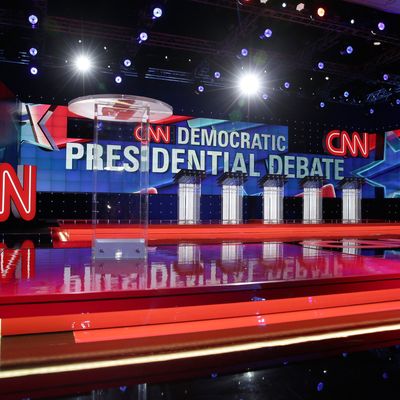
With the first presidential debates of the 2020 cycle less than a month away (June 26 and 27 in Miami), fully 20 candidates have met the Democratic National Committee’s criteria for making the stage then and at the second set of debates (July 30 and 31 in Detroit). Nineteen of them qualified by obtaining one percent of the vote in three national or early-state polls specified by the DNC, and one (Marianne Williamson) qualified by the alternate route of drawing 65,000 donors, with at least 200 donors in 20 states. Twenty happens to be the magic number capping participation in rounds one and two; if additional candidates qualify, those who meet both the polling and grassroots fundraising thresholds (11 candidates, according to a May 9 analysis from FiveThirtyEight) will have precedence, and the tiebreaker among them will be higher polling averages.
The DNC has just announced criteria for two more rounds of debates in the fall, a September 12–13 round (the second-day event dependent on whether more than ten candidates qualify) sponsored by ABC/Univision, and an October event with dates and sponsorship TBD. For these debates, the DNC has literally doubled down on requirements, as CNN reports:
In order to qualify for the third and fourth set of debates in September and October respectively, candidates will now have to achieve 2% in four polls from a slightly changed list of approved pollsters and receive 130,000 unique donors (from the date of their campaign’s creation), including 400 unique donors per state in at least 20 US states …
But the biggest change will be that candidates now have to meet both the polling and donor threshold, not just one like in the first two debates. This is a significant shift that will likely reduce the number of candidates qualified for the third and fourth set of debates.
According to an analysis by FiveThirtyEight on May 22, only eight of the 23 announced candidates (Joe Biden, Cory Booker, Pete Buttigieg, Kamala Harris, Amy Klobuchar, Beto O’Rourke, Bernie Sanders, and Elizabeth Warren) have crossed this higher polling threshold. And it’s unclear how many of those (and others) will be able to meet the fundraising requirements, since those are made known by candidate announcement (subsequently verified by the DNC), not some publicly available data source. But Politico reports some of them are probably home free, based on earlier announcements:
Most campaigns have released little information about the number of individual donors they have, besides announcing when they cross the 65,000-donor mark. Sanders, Buttigieg, Harris and Warren have all publicly said they’ve surpassed 130,000 donors.
Other candidates who may have already exceeded that threshold include O’Rourke (who said he had 112,000 unique donors in his first day) and Biden (who had 96,000 donors in his first day).
Without question, some candidates are going to struggle to make the stage in September. While the DNC threw the door open pretty wide for the first two sets of debates — probably in reaction to complaints about how it handled debates in 2016 — come fall, it’s going to get serious about restricting participation, likely hoping to avoid the need for two debates each round. By the time the leaves begin to turn in New Hampshire, the enormous field will probably already have been “winnowed” as candidates run out of money and volunteers or simply cannot command the media attention necessary to sustain a viable campaign. But the DNC is prepared to do some winnowing of its own. The more poorly positioned candidates would be well-advised to take advantage of the summer debates to strut their stuff and attract a following and a donor base. It’s going to be a matter of political survival.






























